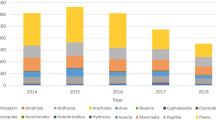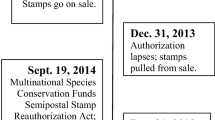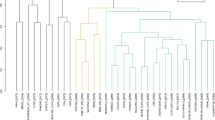Abstract
Implementation of policy involves multiple agencies operating at multiple levels in facilitating processes and actions to accomplish desired results. The Convention on International Trade in Endangered Species of Wild Fauna and Flora (CITES) was developed and implemented to regulate and control international wildlife trade, but violations of the agreement are widespread and growing worldwide, including in Nepal. This study attempts to understand how domestic CITES policies are translated into action and what effect actions and processes have on compliance. In doing so, this study provides insights into the implementation and enforcement pitfalls of national legislation that explain CITES violations in Nepal. Primarily, we used 26 key informants interviews to learn opinions of experts, and the grounded theory approach for further qualitative data analysis. In addition, we used Najman’s (1995) policy implementation analysis framework to explain gaps. Many interrelated variables in the content of the policy, commitment and capacity of the agencies, the roles of clients and coalitions and contextual issues were observed. Variables that emerged suggest pitfalls in the regulatory policy represented by low probability of detection, arrest and punishment. Moreover, redistributive policies in buffer zones of protected areas are needed into perpetuity to benefit locals. Also, conservation organizations’ support for building public and political salience is imperative.


Similar content being viewed by others
Notes
(1 USD = 81.14 NRs, March 22, 2012).
References
Adhikari TK (2002) The curse of success. Habitat Himalaya 11:3
Akella AS, Cannon JB (2004) Strengthening the weakest link: strategies for improving the enforcement of environmental laws globally. Center for Conservation and Government, Conservation International. http://www.oecd.org/dataoecd/18/37/33947741.pdf. Accessed 2 Feb 2011
Aryal RS (2009) CITES implementation in Nepal and India (law, policy and practice). WWF-Nepal, Kathmandu
Baral N, Heinen JT (2006) The maoist people’s war and conservation in Nepal. Politics and the Life Science 24:1–2
Bayrakal S (2006) The US pollution prevention act: a policy implementation analysis. The Social Science Journal 43(1):127–145
Becker GS (1968) Crime and punishment: an economic approach. The Journal of Political Economy 76:169–217
Bernard HR (2006) Research methods in anthropology: qualitative and quantitative approaches 4th edn. Altamira Press, New York
Bhuju UK, Aryal RS, Aryal P (2009) Report on the facts and issues on poaching of mega species and illegal trade in their parts in Nepal. Study commissioned by Transparency International (TIN). http://www.tinepal.org/WWF_OCt_29_final_ukbrbt_Revised.pdf. Accessed 6 Feb 2011
Blundell AG, Mascia MB (2005) Discrepancies in reported levels of international wildlife trade. Conservation Biology 19:2020–2025
CITES (2011) Convention on international trade in endangered species of wild fauna and flora. http://www.cites.org/. Accessed 16 Feb 2011
Damania R, Fredriksson PG, Mani M (2004) The persistence of corruption and regulatory compliance failures: theory and evidence. Public Choice 121:363–390
Damania R, Seidensticker J, Whitten T, Sethi G, Mackinnon K, Kiss A, Kushlin A (2008) A future for wild tigers. World Bank, Washington D.C. http://siteresources.worldbank.org/SOUTHASIAEXT/Resources/Publications/448813-1212785337028/tiger2008.pdf. Accessed 16 Feb 2011
Dangol Y, Paudyal A (2008) Headlines Himalaya: An Environmental Watchdog Newsletter. Issue 15
Dinerstein E, Loucks C, Wikramanayake E, Ginsberg J, Sanderson E, Seidensticker J, Forrest J, Bryja G, Heydlauff A, Klenzendorf S, Leimgruber P, Mills J, O’Brien TG, Shrestha M, Simons R, Songer M (2007) The fate of wild tigers. Bioscience 57:508–514
DNPWC (2007) Tiger conservation action plan for Nepal: 2008–2012. Department of National Parks and Wildlife Conservation, Ministry of Forests and Soil Conservation, Government of Nepal. http://www.dnpwc.gov.np/publications/cat_view/4-publications/8-species-action-plan. Accessed 16 Feb 2011
DNPWC (2008) Annual report 2007–2008. Department of National Parks and Wildlife Conservation, Ministry of Forest and Soil Conservation, Government of Nepal. http://www.dnpwc.gov.np/publications/annual-report. Accessed 4 Dec 2011
DNPWC (2010) Annual report 2009-2010. Department of National Parks and Wildlife Conservation, Ministry of Forest and Soil Conservation, Government of Nepal. http://www.dnpwc.gov.np/publications/annual-report. Accessed 4 Dec 2011
Dobson A, Lynes L (2008) How does poaching affect the size of National Parks? Trends in Ecology & Evolution 23:177–180
Faure M, Lefevere J (1999) Compliance with international environmental agreements. In: Vig NJ, Axelrod RS (eds) The global environment: institutions, law, and policy. CQ Press, Washington, DC, pp 138–156
Ghimire G, Bhatta S (2010) Headlines Himalaya: an environmental watchdog newsletter. Issue 111
Hamilton A, Cunnihgham A, Byarugaba D, Kayanja F (2000) Conservation in a region of political instability: Bwindi impenetrable forest, Uganda. Conservation Biology 14:1722–1725
Heinen JT (2010) The importance of a social science research agenda in the management of protected natural areas, with selected examples. Botany Reviews 76:140–164
Heinen JT, Chapagain DP (2002) On the expansion of species protection in Nepal: advances and pitfalls of new efforts to implement and comply with CITES. Journal of International Wildlife Law and Policy 5:235–250
Heinen JT, Kattel B (1992) A review of conservation legislation in Nepal: past progress and future needs. Environmental Management 16(6):723–733
Heinen JT, Shrestha-Acharya R (2011) The non-timber forest products sector in Nepal: emerging policy issues in plant conservation and utilization. Journal of Sustainable Forestry 30(6):543–562
Heinen JT, Yonzon PB, Leisure B (1995) Fighting the illegal fur trade in Kathmandu, Nepal. Conservation Biology 9:246–254
Hilborn R, Arcese V, Borner M, Hando J, Hopcraft G, Loiboki M, Mduma S, Sinclair ARE (2006) Effective enforcement in a conservation area. Science 314:1266
Jacobson HK, Weiss EB (1998) A framework for analysis. In: Weiss EB, Jacobson HK (eds) Engaging countries: strengthening compliance with international environmental accords, global environmental accord. MIT Press, Cambridge, pp 1–18
Keane A, Jones JPG, Jones GE, Milner-Gulland EJ (2008) The sleeping policeman: understanding issues of enforcement and compliance in conservation. Animals Conservation 11:75–82
Kraft ME, Vig NJ (2009) Environmental policy over four decades: achievements and new directions. In: Vig NJ, Kraft ME (eds) Environmental policy: new directions for the twenty-first century, 7th edn. CQ Press, Washington, DC, pp 1–26
Leader-Williams N, Milner-Gulland EJ (1993) Policies for the enforcement of wildlife laws: the balance between detection and penalties in Luangwa valley, Zambia. Conservation Biology 7:611–617
Lewis MG (2009) CITES and rural livelihoods: the role of CITES in making wildlife conservation and poverty reduction mutually supportive. Journal of International Wildlife Law and Policy 12:248–275
Lewis D, Kaweche GB, Mwenya A (1990) Wildlife conservation outside protected areas—lessons from an experiment in Zambia. Conservation Biology 4:171–180
IUCN Red List (2011) The IUCN Red list of threatened species http://www.iucnredlist.org/apps/redlist/details/32104/0. Accessed 1 Feb 2012
Mandal RA, Jha B, Wagle SK, Ghimire UB, Kalikotey BB (2008) Challenges on control of illegal trade of Pterocarpus Santalinus—a training report. District Forest Office, Ministry of Forest and Soil Conservation, Training Division. District Forest Office, Kathmandu
Martin E (2004) Rhino poaching in Nepal during an insurgency. Pachyderm 36:87–98
Martin EB, Martin C (2006) Insurgency and poverty: recipe for rhino poaching in Nepal. Pachyderm 41:61–73
Martin E, Martin C, Vigne L (2009) Recent political disturbances in Nepal threaten rhinos: lessons to be learned. Pachyderm 45:98–107
McNeely JA, Kapoor VP, Zhi L, Olsvig-Whittaker L, Sheikh KM, Smith AT (2009) Conservation biology in Asia: the major policy challenges. Conservation Biology 23:805–810
Mehta JN, Heinen JT (2001) Does community-based conservation shape favorable attitudes among locals? An empirical study from Nepal. Environmental Management 28:165–177
Milner-Gulland EJ, Leader-Williams N (1992) A Model of incentives for the illegal exploitation of black rhinos and elephants: poaching pays in Luangwa valley, Zambia. Journal of Applied Ecology 29:388–401
Ming L, Zenxiang G, Xinhai L, Sung W, Niemela J (2000) Illegal wildlife trade in the Himalayan region of China. Biodiversity Conservation 9:901–918
Najam A (1995) Learning from the literature on policy implementation: a synthesis perspective. International Institute for Applied Systems Analysis, Laxenburg. http://www.iiasa.ac.at/Admin/PUB/Documents/WP-95-061.pdf. Accessed 2 Dec 2010
Nijman V (2009) An overview of international wildlife trade from Southeast Asia. Biodiversity Conservation 19:1101–1114
Oli KP (2005) Biodiversity resources governance in times of armed conflict. In: McNeely JA, McCarthy TM, Smith A, Whittaker LO, Wikramanayake ED (eds) Conservation Biology in Asia, Society for Conservation Biology Asia Section and Resources Himalaya Foundation, pp 68–83
Ong DM (1998) The Convention on International Trade in Endangered Species (CITES, 1973): implications of recent developments in international and EC environmental law. Journal of Environmental Law 10:2
Ostrom E (1990) Governing the commons: the evolution of institutions for collective action. Cambridge University Press, Cambridge
Pressman JL, Wildavsky A (1973) Implementation: how great expectations in Washington area dashed in Oakland; or why it’s amazing that federal programs work at all. University of California Press, Berkeley
Pretty J (2003) Social capital and the collective management of resources. Science 302:1912–1914
Reeve R (2006) Wildlife trade, sanctions and compliance: lessons from the CITES regime. International Affairs 82:881–897
Ryan GW, Bernard HR (2003) Techniques to identify themes. Field Methods 15:85
Sabatier PA (1986) Top-down and bottom-up approaches to implementation research: a critical analysis and suggested synthesis. Journal of Public Policy 6:21–48
Sebastian T, Dargusch P, Griffiths A (2011) The drivers and outcomes of the clean development mechanism in China. Environmental Policy and Governance 21:223–239
TRAFFIC (2007) The state of wildlife trade in China-information on the trade in wild animals and plants in China. http://www.traffic.org/home/2008/11/12/state-of-wildlife-trade-in-china-finds-consumption-rising-in.html. Accessed 6 Feb 2011
TRAFFIC (2008) What’s driving the wildlife trade. A review of expert opinion on economic and social drivers of the wildlife trade and trade control efforts in Cambodia, Indonesia, Lao PDR, and Vietnam. World Bank, Washington, DC. http://siteresources.worldbank.org/INTEASTASIAPACIFIC/Resources/226262-1223319129600/wildlife_foreword_terms_acknowledgement.pdf. Accessed 15 Jan 2011
TRAFFIC North America (2009) Wildlife trade control: CAFTA-DR Regional gap analysis report. TRAFFIC North America, World Wildlife Fund, Washington D.C. www.traffic.org/general-reports/traffic_pub_gen31.pdf. Accessed 9 Feb 2011
Tremblay MA (1957) The key informant technique: a nonethnographic application. American Anthropologist 59:688–701
UNEP (United Nation Environmental Programme) (2006) Manual on compliance with and enforcement of multilateral environmental agreements. United Nation Environmental Programme. http://www.unep.org/dec/docs/unep_manual.pdf. Accessed 25 May 2010
UNEP-WCMC (2011) CITES Trade Database http://www.unep-wcmc.org/citestrade/trade.cfm. Accessed 7 Jan 2011
Victor DG (1998) The implementation and effectiveness of international environmental commitments: theory and practice. Global Environmental Accords, International Institute for Applied Systems Analysis, Laxenburg, Austria. MIT Press, Cambridge
Vogel D, Kessler T (1998) How compliance happens and doesn’t happen domestically. In: Weiss EB, Jacobson HK (eds) Engaging countries: strengthening compliance with international environmental accords, global environmental accords. MIT Press, Cambridge, pp 19–37
Walston JK, Karanth U, Stokes EJ (2010) Avoiding the unthinkable: what will it cost to prevent tigers becoming extinct in the wild? Wildlife Conservation Society, New York. http://www.globaltigerinitiative.org/download/ELF/session-papers-and-presentations/TIGER-REPORT-Part-1-small.pdf. Accessed 7 Jan 2011
Wasser SK, Clark B, Laurie C (2009) The ivory trail. Scientific American 301:68–76
Weiss EB, Jacobson HK (1998) Engaging countries: strengthening compliance with international environmental accords, global environmental accords. MIT Press, Cambridge
Welch EC (1999) Implementation of environmental policy in the Katowice administrative region: a cause for concern? International Journal of Environmental Studies 56(3):28–259
Wells MP, Brandon KE (1993) The principles and practice of buffer zones and local participation in biodiversity conservation. Ambio 22:157–162
Wyler LS, Sheikh PA (2008) International illegal trade in wildlife: threats and U.S. policy. Congressional Research Service report for Congress. Penny Hill Press, Damascus, Maryland. http://fpc.state.gov/documents/organization/110404.pdf. Assessed 7 Jan 2011
Yonzon P (2005) The illicit trade on megavertebrates of Asia. In: McNeely JA, McCarthy TM, Smith A, Whittaker LO, Wikramanayake ED (eds) Conservation Biology in Asia, Society for Conservation Biology Asia Section and Resources Himalaya Foundation, pp 84–91
Zhou M (2004) Research on woody material of Chinese furniture of the Ming and Qing Dynasties—the Red Sandal Wood. Collectors (Shoucangjia) 2004:4–5 In Chinese
Acknowledgments
We thank the Asian Studies Program and the Earth and Environment Department at Florida International University for providing financial support to the first author. We also thank all informants for graciously responding to our requests for interviews. This paper is dedicated to the memory of Dr. Pralad Yonzon, friend and mentor, who continuously and consistently encouraged our work in conservation in Nepal.
Author information
Authors and Affiliations
Corresponding author
Rights and permissions
About this article
Cite this article
Dongol, Y., Heinen, J.T. Pitfalls of CITES Implementation in Nepal: A Policy Gap Analysis. Environmental Management 50, 181–190 (2012). https://doi.org/10.1007/s00267-012-9896-4
Received:
Accepted:
Published:
Issue Date:
DOI: https://doi.org/10.1007/s00267-012-9896-4




